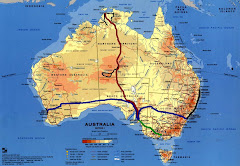Historically, the Nullarbor was inhabited by the semi-nomadic Spinifex Wangai Aboriginal people. The average rainfall on the Nullarbor Plain is about 200 mm per year.
European settlers were determined to cross the plain, despite the hardships created by the nature of the Nullarbor. Although Edward John Eyre described the Plain as "a hideous anomaly, a blot on the face of Nature, the sort of place one gets into in bad dreams", he became the first European to successfully make the crossing in 1841.
The plain is a series of tiers. Each tier is flat and was formed when the sea level was much higher than it is today.
The southern ocean, in areas, blows through many subterranean caves resulting in blow holes up to several hundred metres from the coast. One such area open for public inspection are the Murrawijinie Caves, in South Australia.
Vegetation in the area is primarily low saltbush and bluebush scrub. A large part of the Nullarbor Plain is now a National Park.
The Nullarbor is known for extensive meteorite deposits, which are extremely well-preserved in the arid climate. In particular, many meteorites have been discovered around Mundrabilla, some up to several tonnes in weight.
The Trans-Australian Railway railway line crosses the Nullarbor Plain from Kalgoorlie to Port Augusta. Construction of the line began in 1917, when two teams set out from Kalgoorlie in Western Australia and Port Augusta in South Australia, meeting in the centre of the Plain at Ooldea, an uninhabited area noted for a water supply. This original line suffered severe problems with track flexing and settling in the desert sands, and journeys across the Plain were slow and arduous. The line was entirely rebuilt in 1969, as part of a project to standardise the previously disparate rail gauges in the various states, and the first crossing of the Nullarbor on the new line reached Perth on 27 February 1970.
In utter vastness whatever is there seems to be even more special.














No comments:
Post a Comment